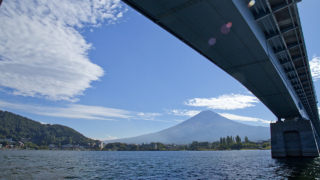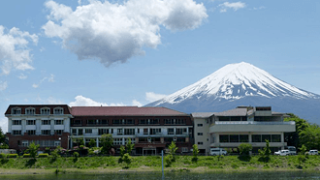HOME
Around Lake Kawaguchiko, there are a lot of places where you can feel the history and culture. Even places you might not even notice could hold great excitement and discoveries. Why don’t you drop in at such places between sightseeing and leisure?
Kawaguchiko.net Listing Information Map
About Lake Kawaguchiko
Lake Kawaguchiko is one of Fuji Five Lakes in Fujikawaguchiko-machi. “Fuji Five Lakes has “Lake Kawaguchiko”,“Lake Motosuko”,“Lake Shojinko”,“Lake Saiko”and “Lake Yamanakako”. Four lakes other than Lake Yamanakako are in Fujikawaguchiko-town."
Lake Kawaguchiko is the second largest of the Fuji Five Lakes after Lake Yamanakako. It is also the second shallowest, with a depth of 14.6m. While Lake Motosuko is the third largest lake, its water capacity is about six times that of Lake Kawaguchiko. This is because Lake Motosuko is the deepest of the Fuji Five Lakes, with a maximum depth of 121m.
| Above sea | Deepest | Around | Area | Water volume (km3×1000) | |
|---|---|---|---|---|---|
| Motosuko | 902m | 121.6m | 11.8km | 4.7km2 | 316 |
| Shojiko | 902m | 15.2m | 6.8km | 0.5km2 | 3.5 |
| Saiko | 902m | 71.7m | 9.9km | 2.1km2 | 80.1 |
| Kawaguchiko | 830m | 14.6m | 21.0km | 5.7km2 | 53 |
| Yamanakako | 982m | 13.3m | 13.9km | 6.8km2 | 64 |
Comparison and position of Fuji Five Lakes
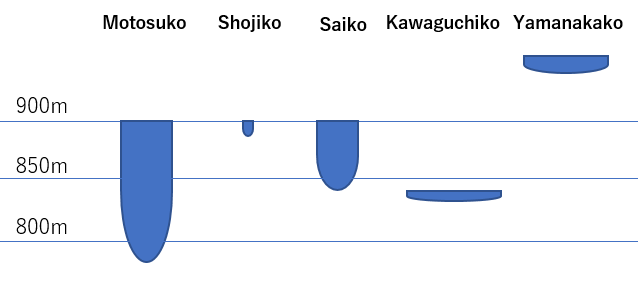
The three lakes—Motosuko, Shojiko, and Saiko—were once a single large lake known as 'Lake Kosenoumi’. As a result, all three are at the same elevation of 902 meters.
Mount Fuji’s repeated eruptions caused lava flows that divided the large lake into the three separate lakes we see today. Since they are connected by the same groundwater veins, a major characteristic is that their water levels are linked.
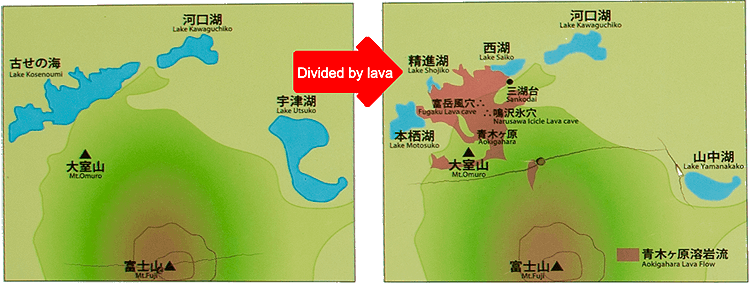
Sankodai," which means “three-lakes viewpoint" in Japanese, is an observation deck located on the south side of Lake Saiko. From here, you can see a view of Lake Motosuko, Lake Shojiko, and Lake Saiko, along with the Aokigahara Jukai Forest, which was formed by lava.

On June 22, 2013, the Fuji Five Lakes, including Lake Kawaguchiko, were designated as a World Cultural Heritage site under the name 'Fujisan, Sacred Place and Source of Artistic Inspiration.’ In Fujikawaguchiko town, there are also component assets such as Kawaguchi Asama Shrine, Fuji Omuro Sengen Shrine, and Funatsu Tainai Lava Tree Molds.
Lake Kawaguchiko is the only one of the Fuji Five Lakes to have both an island and a bridge. Unoshima Island is an Important Cultural Property of Fujikawaguchiko Town, and the view of the island from Oishi Park with Mount Fuji in the background is very popular. The Kawaguchiko Ohashi Bridge is about 500 meters long. The bridge was chosen as one of the '100 Best Roads in Japan,’ and a monument stands at its southern end.

Annual Events around Lake Kawaguchiko
Around Lake Kawaguchiko, you can enjoy Mount Fuji’s seasonal scenery throughout the year, as well as festivals related to the mountain.
| Jan. | From 24 every Sat. and Sun. : Kawaguchiko Winter Fireworks Festival |
| Feb. | to 23, every Sat. and Sun. : Kawaguchiko Winter Fireworks Festival |
| Mar. | |
| Apr. | From 01 to 20 : Fujikawaguchiko Cherry Blossoms Festival, From 12 : Fuji Shibazakura Festival, 25 : Kawaguchi Asama shrine Festival “Magomi Matsuri”, 29 : Horseback Archery Festival (Yabusame) |
| May | to 25 : Fuji Shibazakura Fastival |
| Jun. | From 22 : Kawaguchiko Herb Festival |
| Jul. | to 15 : Kawaguchiko Herb Festival, 5 : Mt.Fuji Climbing Season Opening Fireworks Celebration, 28 : Kawaguchi Asama shrine “Daidai-okagurasai" (Shinto music and dance) |
| Aug. | 5 : Lake Kawaguchiko Fireworks Festival and “Kojosai” |
| Sep. | 9 : Fuji Omuro Sengen shrine Autumn Annual Festival, 18 : Hachioji shrine, Tsutsuguchi shrine Autumn annual festival |
| Oct. | |
| Nov. | From 01 to 30 : Fujikawaguchiko Momiji Festival |
| Dec. | 14 : Fujisan Marathon |
Climate of Kawaguchiko
Kawaguchiko Station is located at an altitude of 857 meters, while Lake Kawaguchiko is at 830 meters. As a result, the average temperature is 5-6 degrees Celsius lower than in Tokyo. From December to March, the minimum temperature often drops below 0 degrees Celsius.
However, as summer temperatures often exceed 30℃ recently, it’s no longer seen as the summer retreat it used to be.
2024 Temperature and precipitation
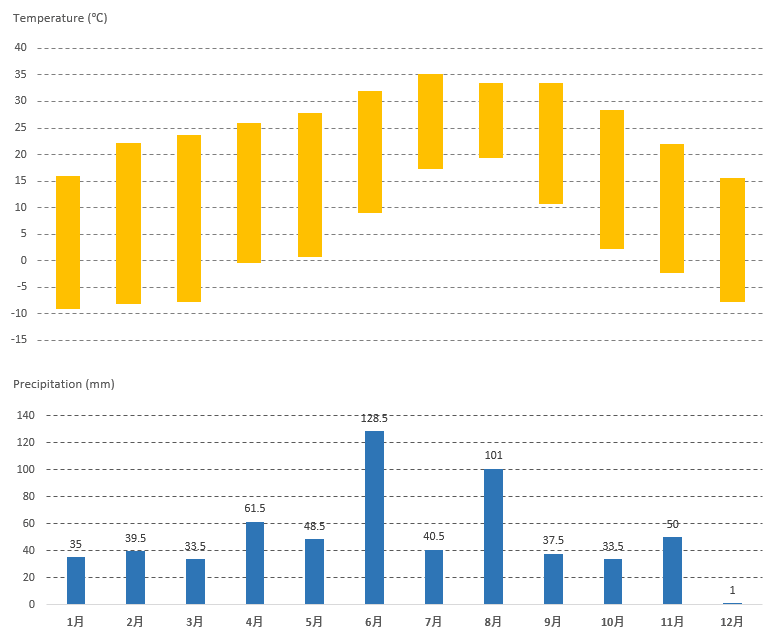
| Jan. | Feb. | Mar. | Apr. | May | Jun. | Jul. | Aug. | Sep. | Oct. | Nov. | Dec. | |
|---|---|---|---|---|---|---|---|---|---|---|---|---|
| High(°C) | 16.0 | 22.1 | 23.7 | 25.9 | 27.8 | 32.0 | 35.2 | 33.5 | 33.5 | 28.3 | 21.9 | 15.5 |
| Low(°C) | -9.1 | -8.1 | -7.7 | -0.4 | 0.7 | 9.0 | 17.3 | 19.4 | 10.7 | 2.2 | -2.3 | -7.7 |
| Ave.(°C) | 1.5 | 2.8 | 4.3 | 12.4 | 15.2 | 18.4 | 24.7 | 24.2 | 21.9 | 15.6 | 9.1 | 1.9 |
| Prec.(mm) | 35.0 | 39.5 | 33.5 | 61.5 | 48.5 | 128.5 | 40.5 | 101.0 | 37.5 | 33.5 | 50.0 | 1.0 |

